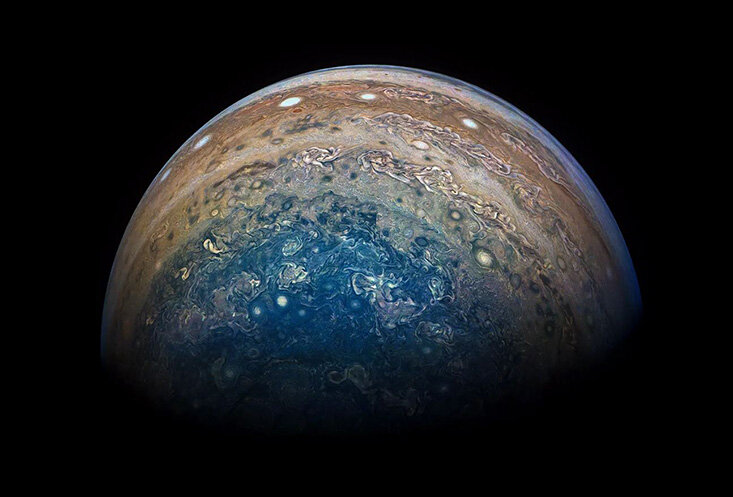
[ad_1]

The planet Jupiter. Credits: NASA / JPL-Caltech / SwRI / MSSS / Gerald Eichstadt / Sean Doran
The whirlpools, eddies, and undulating bands of Jupiter and Saturn may remind us of a relaxing, starry, starry night, but they reveal that these two gas giants are stormy and turbulent places. Turbulence produces cascades of energy, a non-linear energy transfer between different scales of motion. These are as fundamental to understanding planetary dynamics as the cardiovascular system is to understanding the human body.
But scientists haven’t had a reliable way to quantify planetary turbulence, until now.
A global team led by University of Rome scientists, which included Boris Galperin, Ph.D., professor at the USF College of Marine Science, described the progress in Geophysical Research Letters. The results show that the speed of energy transfer of turbulence – until now a black box of mystery – can be calculated relatively simply from a variable related to planetary rotation and known as potential vorticity (PV).
The method was first developed by Galperin and his graduate student, Jesse Hoemann, and tested in experiments conducted at the University of Rome during Jesse’s visit there. The method was confirmed using actual velocity data extracted from Jupiter cloud motion images captured by the 20-year-old Cassini mission, further laboratory results performed in a rotating tank at the University of Rome in Italy, and computer simulations for Saturn.
Based on the PV calculations, the team showed for the first time that the rate of energy transfer in Jupiter’s atmosphere is four times faster than that of Saturn.

Banded flows on Jupiter and Saturn (from Cassini) and in a rotating tank experiment by Cabanes et al. (2020), which shows non-monotone PV profiles. Credit: University of South Florida
“Now you can see why I was really excited about this work,” said Galperin, who developed the original idea for the experiments several years ago.
Because the laws of turbulence, like all basic physical laws, are universal, the method can now be applied to other natural environments such as the ocean, Galperin said. Eddies in the Earth’s ocean that resemble eddies on Jupiter, for example, have varying strengths, sizes, and lives and are critical to understanding the balances of energy, heat, salt, carbon dioxide, and more.
“This is the first estimate of Saturn’s turbulent power from observations, and this study paves the way for future analysis of data in other planetary atmospheres,” said lead author Simon Cabanes, Ph.D., a post doc at the Department of Civil and Environmental Engineering (DICEA) of the University of Rome La Sapienza.
Time on Jupiter and Saturn can be driven by different forces than on Earth
Simon Cabanes et al. By revealing the intensity of turbulent energy transfer in planetary atmospheres, Geophysical Research Letters (2020). DOI: 10.1029 / 2020GL088685
Provided by the University of South Florida
Quote: Scientists Discover New Way to Measure Turbulence of Large Planets and Exoplanets (2020, Dec 2) Retrieved Dec 2, 2020 from https://phys.org/news/2020-12-scientists-turbulence-large-planets- exoplanets.html
This document is subject to copyright. Aside from any conduct that is correct for private study or research purposes, no part may be reproduced without written permission. The content is provided for informational purposes only.
[ad_2]
Source link